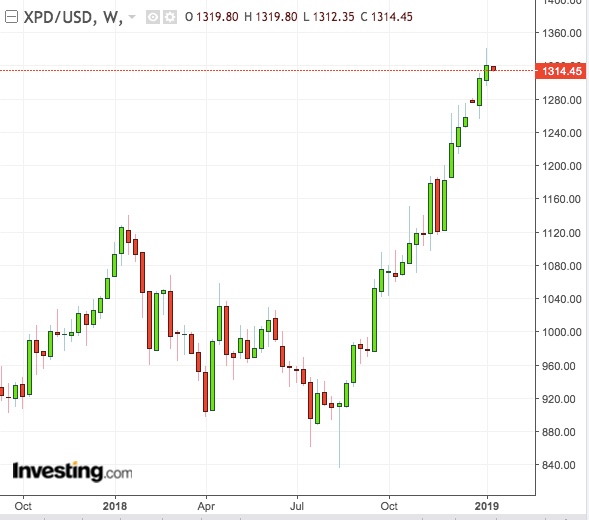The path of least resistance in oil is higher. Even oil bears will agree. What remains an enigma is how much further the bull market can go without flipping as Saudi determination to cut supply faces China’s vulnerable economy and its drag on global energy demand.
Oil bulls, of course, have much to rejoice from Saudi Arabia's vow to "rebalance" the market. Saudi Energy Minister Khalid al-Falih said last week the Kingdom was pumping approximately 800,000 barrels less a day from a record high of 10.2 million barrels per day in November. The amount Riyadh would ship overseas in February would be another 100,000 bpd less than January's 7.2 million bpd, he added.

In the second phase of its rebound toward $60, U.S. West Texas Intermediate crude could be testing $55 per barrel. The first phase occurred less than two weeks into the New Year, with WTI showing by Friday’s close a 22 percent gain from the 18-month lows of $42.36 hit on Christmas Eve.
$60 WTI Would Mark 42% Jump From Christmas Eve
If WTI gets to $60 by the end of January, it would mark a 42 percent rebound from 2018 lows. Percentage-wise, that is more than last year’s tumble. It would also be a phenomenal recovery if it achieves that within a month, considering that the selloff itself lasted over three months.
Still, at $60 per barrel, WTI would have regained only $17 of the $37 it lost from 2018’s highs. And there are doubts on how fundamentally-supported the rally is.
Dominick Chirichella of the Energy Management Institute in New York expressed at the weekend the worry that some investors and traders had about the comeback story in oil:
“There is still concern over the state of the global economy … whether it is moving toward a sustainable slow down, and even a recession, in some areas of the world.”
And no area in the world is probably as important for growth as China, where a near year-long trade war between the government in Beijing and the Trump Administration in the U.S. stifled the word's second largest economy.
China Worries Could Hamper Oil Demand
While WTI settled last week with its biggest weekly gain in at least six months, up almost 8 percent, Friday's market itself was down as investors took profit after concerns that the latest U.S.-Sino talks ended without a positive outcome.
U.S. officials to the talks said any agreement struck with Beijing must provide complete "verification and effective enforcement", with Chinese officials responding that “both parties” had an obligation to keep their promises. To say that neither side trusts the other would be an understatement. There are just about 45 days for the two sides to make a deal before the March 1 deadline that will bring more U.S. tariffs on $200 billion worth of Chinese goods.
Even if a trade deal is struck, there are worries that China’s 2019 growth could be one of the lowest since 1990. Being the world's biggest oil consumer, any significant slide in China's economy will have major ramifications for energy demand.
China aside, WTI at above $50 also brings fears of another upswing in U.S. shale production, which surged by than 2 million barrels per day in 2018 to a record 11.7 million bpd. Reuters cited consultancy JBC Energy as saying last week that it was possible that U.S. output was “significantly above 12 million bpd” this month.
Palladium Trumps Gold As Most Valuable Metal
Away from oil, one of the strongest commodities is palladium, the world’s most valuable metal since last week, after the spot price of the auto-catalyst metal consistently hit record highs above $1,300 per ounce, trumping gold.

Palladium’s rally began more than a year ago, in October 2017, but last week it peaked as investors linked the precious metal used for purifying auto emissions with a Chinese government announcement that could boost car ownership.
But industrial demand could only be one aspect of the palladium story.
Walter Pehowich, executive vice-president at Dillon Gage Metals in Addison, Texas, said speculative activity more than anything else was driving palladium “as more and more interest from investors enters this thin and relatively small market”.
To give an idea of the froth in the market, Pehowich cites the open interest in March futures of palladium, which stood at 25,000 contracts amounting to 2.5 million physical ounces, versus physical stocks of 44,000 ounces in warehouses linked to the Chicago Mercantile Exchange.
Investor Interest In Palladium Way Above Supply
Said Pehowich:
“We are still six weeks away from the first notice day on the exchange in the March palladium contract. In the past the exchange did a superb job of limiting the amount of contracts one house could hold and never had a problem. But we've never seen the price of palladium this high, and with so much new investor interest, it will be interesting to see what the exchange does to avoid a potential problem.”
Consultancy Metals Focus said that while palladium supply from major producers including Russia and South Africa wasn’t growing, global automotive demand for the metal was expected to have reached a record 8.5 million ounces last year.
Anton Berlin, head of analysis and market development at Norilsk Nickel PJSC, was quoted by Bloomberg saying that combined palladium use in hybrid and plug-in hybrid—or rechargeable —vehicles will be nearly triple that of 2016 by 2020.
Analysts at JPMorgan also said hybrids were forecast to grow from just 3 percent of global market share in 2016 to 23 percent of sales by 2025.
Added Pehowich: “We will be watching closely to see how this pans out.”
